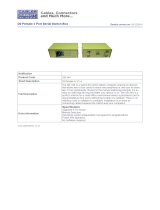
12 Digi Intelligent Asynchronous Serial Communications Systems
Per-Card Parameters — ISA, EISA, Micro Channel
The remaining three parameters are per-card parameters, and are used to inform
the driver of the type of board and where it is to be addressed in the host’s I/O
and memory buses. Except as noted, these parameters are mandatory, and must
be given for each board!
The per-card parameters must be given in complete sets, and the sets must be
separated by commas.
/T:adapter (C/X, EPC/X, Xem and Xr only)
Defines the adapter type to the driver. Legal values for adapter are: I for
the AccelePort C/X - ISA, E for the AccelePort C/X - EISA, M for the
AccelePort C/X - MC, C for AccelePort EPC/X systems (all bus types) P for
AccelePort Xem systems (all bus types) and A for AccelePort Xr boards (all
bus types). The designators I, E, M and C must be followed by an additional
two digits defining the arrangement and number of concentrators on each
host adapter channel. If there are any 8-port concentrators in a
configuration, their position in the configuration must be specified by
placing the number of ports per concentrator (including 16-port
concentrators) in curly brackets ({}) immediately following the number of
concentrators per line. If there is more than one concentrator, the number of
ports on each concentrator must be included and separated by semicolons.
If there are no parameters in curly brackets, all concentrators on that line are
assumed to have 16 ports. If the concentrator(s) are connected to the host
adapter via a dial-up or leased line (remote concentrators), each of the two
digits must also be followed by a parameter, enclosed in parentheses, which
specifies the synchronous communications mode to be used for that line.
See page 30 for a list of available synchronous communications modes.
/T:P AccelePort Xem host adapter.
/T:A AccelePort Xr.
/T:I10 AccelePort C/X - ISA host adapter, one local 16-port
concentrator on line 1 (and nothing on line 2).
/T:E11 AccelePort C/X - EISA host adapter, one local 16-port
concentrator on each of lines 1 and 2.
/T:M21{8}
AccelePort C/X - MC host adapter, two local 16-port
concentrators on line 1, and one local 8-port concentrator on
line 2.





















